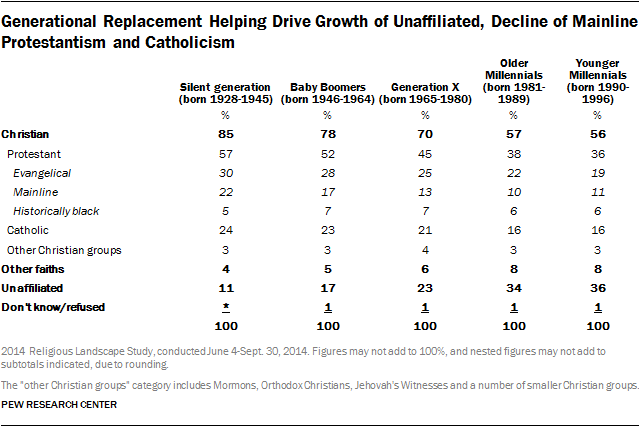Pew released its Religious Landscape Survey, a massive overview of religious demographics and affiliation in the United States. Here’s a few facts that caught my eye:
1. The unaffiliated are on the rise, and it’s generational.
I wasn’t going to include this. Every media outlet covering the report is headlining with this and I was going to be creative.
But wow, those numbers are telling:
 Take a look at that top row. Among people surveyed born before 1945, 85% identify as Christian – compared to only 56% born between 1990 and 1996. (The number of the unaffiliated went up across every generation – but the younger the group, the higher the gain.)
Take a look at that top row. Among people surveyed born before 1945, 85% identify as Christian – compared to only 56% born between 1990 and 1996. (The number of the unaffiliated went up across every generation – but the younger the group, the higher the gain.)
As a raw number, that doesn’t actually give us much to go for guessing what that means for American religion long-term – reports of the death of American Christianity and coming secular era are, I would say, a bit premature or oversimplified for a lot of reasons. But it’s definitely a noteworthy drop.
2. Among the “nones,” atheism and agnosticism are on the rise.
In 2007, 25% of “nones” described themselves as atheist or agnostic. In 2014, 31% of “nones” used those terms.
This is kind of surprising to me, since “atheist” and “agnostic” seem to imply an active rejection of religion rather than the slow indifferent slide away from it that a generational shift towards “none-ness” suggests. One possible guess is that those terms have become less stigmatized, even though surveys find that people still aren’t sure they’d vote for an atheist.
3. Pope Francis might be popular, but he isn’t bringing in the members.
The Catholic Church didn’t experience the greatest loss of members in this survey – that was mainline Protestants – but it was a close call. It isn’t true that there are more former Catholics than Catholics – 13% of Americans are former Catholics, and 21% are currently Catholics. But that’s down about 3% since 2007 – and it loses more members to conversion to other faiths (or leaving to become unaffiliated) than any other group.
4. Historically black churches are REMARKABLY stable.
I won’t include the relevant charts because I would have to include all of them, but here’s some numbers: Across generations, the percentage of Americans identifying as members of historically black churches remained steady, between 5% and 7%. Diversity increased in every American faith group, except historically black churches (perhaps for obvious reasons). Pretty close to the same number of people left historically black churches as joined them, where other churches saw much larger drops in numbers.
I don’t know enough about historically black churches to hazard a guess about where this stability comes from, but in a survey that found huge changes it was pretty striking. The Catholics should ask them how they do it.
5. The “nothing in particular” group is exactly racially representative of the country as a whole.
64% of people who say their religion is “nothing in particular” are white, 12% are black, 5% are Asian, and 15% are Latino. Incidentally, about 64% of Americans are white, about 12% are black, about 5% are Asian, and about 16% are Latino or Hispanic.
This is noteworthy because it’s emphatically not true of every other major religious group. Mainline Protestantism is whiter, by quite a lot, than America overall. Evangelicals are also more likely to be white. Catholics lean Latino, historically black churches (obviously) tend to be more black. The unaffiliated (such as atheists and agnostics, which is a different group from people who decline to identify with anything at all) are pretty close to representative, but still more likely to be white.
But the “nothing in particular” group lines up almost exactly with the racial demographics of the country as a whole. I am intrigued by this. Share your theories in the comments.